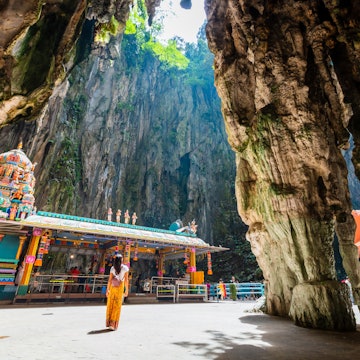
Plan your next adventure with these expert tips from a Lonely Planet writer

Nov 27, 2019 • 7 min read

With these expert travel-planning tips, you can maximize your next vacation. Kiattisak Lamchan / EyeEm / Getty
Being a travel writer for Lonely Planet has broadened my skills in interesting ways. I’ve developed the nerve to drive narrow mountain roads and the stomach to sample the world’s moldiest cheeses. When it comes to identifying bug bites, I have the knowledge (and probably the anti-itch spray). Best of all, I’ve got trip planning down to an art.
If you want to be a travel writer, you need to appreciate a good spreadsheet as much as a tropical sunset. Professional travel writers squeeze every last minute out of their trips, usually on a slim budget. The privilege of traveling the world and writing about it comes with high pressure and tight deadlines. That means travel writers are tireless at finding bargains, pros at crafting itineraries, and able to travel nimbly while ensuring their experiences are as rich as their readers deserve. I’ve covered more than a dozen countries for Lonely Planet’s guidebooks, and here are a few tips I’ve learned along the way.
1. Play with multiple searches and planning tools
When looking for transport and accommodation, I treat the internet as a giant, messy laboratory. For flights, I use a combination of Google Flights for reference, email alerts and error fare websites like AirFare Watchdog, and Skyscanner to compare fares across a range of dates. With hotels, booking directly often produces the best rate but I always do extra searches via aggregators like Booking.com.
Make sure you’re comparing like with like: are taxes, breakfasts and resort fees included? Above all, experiment with multiple tools and approaches. I once saved hundreds of dollars on car rental by logging out of the very rewards program I had assumed would unlock cheaper prices – loyalty doesn’t always pay!
2. Be open-minded in the early planning stages
A little imagination can transform the price of your trip, as well as open up interesting detours. If you’re flying, search routes into neighboring airports – even those beyond your desired country (for example, Vienna and Bratislava each have international flights and they’re a direct bus ride apart). If a layover significantly reduces the fare, consider whether it can be transformed into a feature of the trip: perhaps an airport spa in Singapore, a walking tour of Amsterdam, a few bleary hours in Reykjavík’s Blue Lagoon?
If you aren’t traveling long-haul, reconsider the need to fly. London to Berlin is a fast plane journey, but does it beat a picnic aboard the Eurostar to Brussels, an evening of chips and Belgian beer, followed by a scenic train ride the next day?
By thinking creatively, fueled by travel inspo from blogs, forums and a Lonely Planet guidebook, you might even decide on a trip more exciting than your original plan. If it weren't for a series of “what ifs,” I would never have ended up on holiday in Moldova – and the country’s wine labyrinths and remote monasteries are still among my most treasured travel memories.

3. Clear paperwork hurdles early
The four horsemen of travel failure are passports, visas, cash flow and insurance. They’re all dull to think about, but they’re also expensive and time-consuming to fix. Double-check if you need a visa and examine your passport early (its expiration may need to be three or six months beyond your trip dates). Log on to your online banking to add travel alerts to reduce the risk of spending day one of your trip begging to restore your debit card’s functionality. Lock down travel insurance and actually read the fine print (OK, skim-read). And while you’re in travel-planning mode, request your vegetarian in-flight meal, reserve train or plane seats, and everything else you can theoretically do until the day before you depart. In my experience, these are exactly the details that get forgotten in the run-up to a trip.
4. Design a killer itinerary (that won’t kill you)
Building an action-packed itinerary is a balancing act. A string of one-night stays in different places is more endurance race than vacation; big-ticket cities and outdoor activity hubs deserve at least a couple of nights each. If your itinerary is looking busy, think about trimming a destination or planning day-trips from one base – you’ll lose less time to packing and hotel check-ins.
Scrutinize the beginning and end of the trip: don’t book the best activities for day one (transport delays, jet lag…) and re-think long drives or rickety train connections on the last day. Use Google Maps to calculate timings for a road trip, but beware of searching routes in summer that you intend to drive in winter. I learned that the hard way, while driving a snow-bogged four-hour detour in the French Alps.
5. Balance forward-planning with spontaneity
Some travelers create detailed plans in advance, others go with the flow. The best travelers do a mixture of both, because neither high-detail planning nor devil-may-care spontaneity works 100% in every destination.
The trick is knowing when to apply each strategy, so browse travel forums, ask well-traveled friends, and learn from disappointed TripAdvisor users. It’s all essential to learning which aspects of your trip would benefit from forward planning (such as netting a reasonably-priced hotel in a ski resort) and where you can be spontaneous (like last-minute accommodation during Europe’s shoulder season, or lining up for cut-price Broadway tickets in NYC).

6. Leave a blank at the end of every itinerary
Travel writers usually have hectic itineraries but we always try to add a spare day or two to the end of a trip. A schedule-free day is invaluable for following local recommendations: exploring a lesser-visited town, hiking, or maybe saying yes to a Valentine’s Day party by Lake Baikal (highlight of my Siberia trip).
Occasionally the bonus day is consumed by transport or health mishaps, but it’s a useful buffer if you need to adjust any plans. On one assignment in Malaysia, I had to dedicate my spare 24 hours to investigating which soft drink is best after a bout of food poisoning – it’s 100PLUS, if you’re wondering – but at least I didn’t lose a research day.
7. Maintain tech-free backups
I’m glued to my mobile phone when I travel. I plot out routes using Google Maps and navigate using OsmAnd. I snap reference pictures with my phone and use voice recording apps for interviews. Though I use Google Fi to get free international roaming, I sometimes buy a SIM card – on assignments it’s handy to have a local number to give out.
Despite staying plugged in, I always prepare for connectivity issues. When my phone suddenly overheated on my last trip to Bulgaria, I was glad to have scribbled down my travel plans on paper. For the same reason, it’s worth printing boarding passes: phones have a habit of freezing right at the moment you’re trying to flash a ticket or load up a hotel confirmation number. And while ATMs in most parts of the world accept major cards, I try to arrive with local currency – it’s saved me when the lone ATM in Arrivals is broken and the bus driver only accepts cash.

8. Pack a little for a lot of situations
On my very first solo trips in my teens, I over-prepared. It was obvious to anyone who saw me waddling along under the weight of my overstuffed rucksack. I had snacks crammed into every spare pocket, a bulging bag of just-in-case medical supplies, enough tampons for an all-female mission to Mars.
Later, when I started going on travel writing assignments, I urgently needed to streamline. Unless traveling to somewhere seriously remote, it’s usually sufficient to pack a little for a lot of situations, limiting yourself to one non-perishable food item (for delays or late-night arrivals) or a single bottle of painkillers (enough to tide you over until you can reach a pharmacy).
Prioritize items with multiple uses: I love big lightweight scarves for keeping warm on planes, covering up in mosques and churches, hanging as a privacy screen in hostel bunks, and padding around fragile souvenirs. Allowing a little breathing room – in your luggage, itinerary and expectations – ensures the happiest of travels.
You might also like
How to plan a bachelor or bachelorette party abroad
10 ways to improve your travels in 2020
Here are 20 cheap places to fly in 2020













